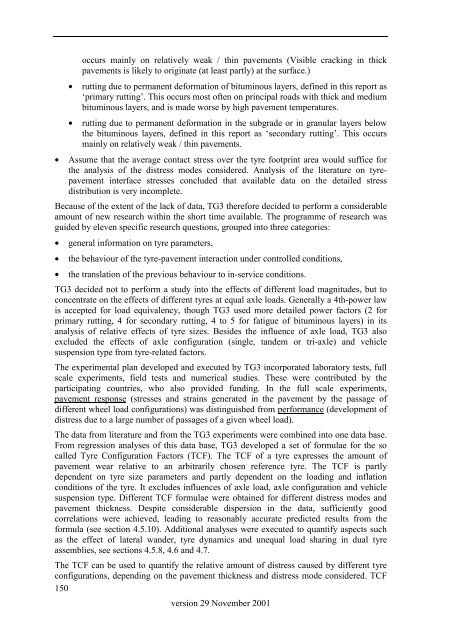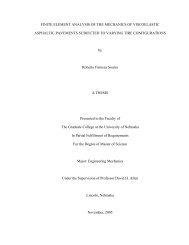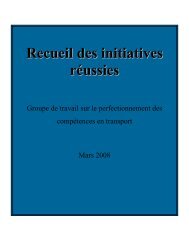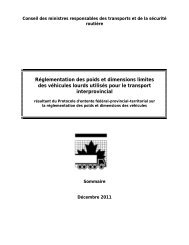You also want an ePaper? Increase the reach of your titles
YUMPU automatically turns print PDFs into web optimized ePapers that Google loves.
occurs mainly on relatively weak / thin pavements (Visible cracking in thickpavements is likely to originate (at least partly) at the surface.)• rutting due to permanent deformation of bituminous layers, defined in this report as‘primary rutting’. This occurs most often on principal roads with thick and mediumbituminous layers, and is made worse by high pavement temperatures.• rutting due to permanent deformation in the subgrade or in granular layers belowthe bituminous layers, defined in this report as ‘secondary rutting’. This occursmainly on relatively weak / thin pavements.• Assume that the average contact stress over the tyre footprint area would suffice forthe analysis of the distress modes considered. Analysis of the literature on tyrepavementinterface stresses concluded that available data on the detailed stressdistribution is very incomplete.Because of the extent of the lack of data, TG3 therefore decided to perform a considerableamount of new research within the short time available. The programme of research wasguided by eleven specific research questions, grouped into three categories:• general information on tyre parameters,• the behaviour of the tyre-pavement interaction under controlled conditions,• the translation of the previous behaviour to in-service conditions.TG3 decided not to perform a study into the effects of different load magnitudes, but toconcentrate on the effects of different tyres at equal axle loads. Generally a 4th-power lawis accepted for load equivalency, though TG3 used more detailed power factors (2 forprimary rutting, 4 for secondary rutting, 4 to 5 for fatigue of bituminous layers) in itsanalysis of relative effects of tyre sizes. Besides the influence of axle load, TG3 alsoexcluded the effects of axle configuration (single, tandem or tri-axle) and vehiclesuspension type from tyre-related factors.The experimental plan developed and executed by TG3 incorporated laboratory tests, fullscale experiments, field tests and numerical studies. These were contributed by theparticipating countries, who also provided funding. In the full scale experiments,pavement response (stresses and strains generated in the pavement by the passage ofdifferent wheel load configurations) was distinguished from performance (development ofdistress due to a large number of passages of a given wheel load).The data from literature and from the TG3 experiments were combined into one data base.From regression analyses of this data base, TG3 developed a set of formulae for the socalled Tyre Configuration Factors (TCF). The TCF of a tyre expresses the amount ofpavement wear relative to an arbitrarily chosen reference tyre. The TCF is partlydependent on tyre size parameters and partly dependent on the loading and inflationconditions of the tyre. It excludes influences of axle load, axle configuration and vehiclesuspension type. Different TCF formulae were obtained for different distress modes andpavement thickness. Despite considerable dispersion in the data, sufficiently goodcorrelations were achieved, leading to reasonably accurate predicted results from theformula (see section 4.5.10). Additional analyses were executed to quantify aspects suchas the effect of lateral wander, tyre dynamics and unequal load sharing in dual tyreassemblies, see sections 4.5.8, 4.6 and 4.7.The TCF can be used to quantify the relative amount of distress caused by different tyreconfigurations, depending on the pavement thickness and distress mode considered. TCF150version 29 November 2001






